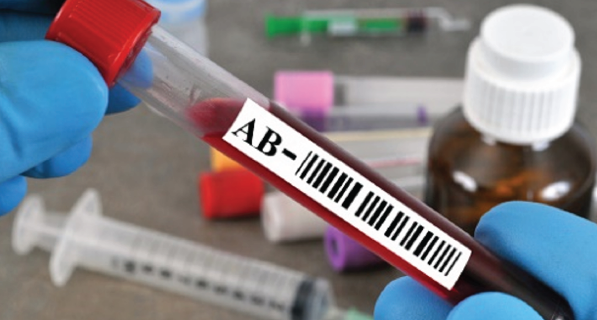What usually comes to mind when you think about the meaning of “rare”? Probably something that is uncommon or special, like a rare gift, a rare occasion or a rare gem. Other dictionary definitions of “rare” include “seldom occurring, scarce, unique, exceptional.”
You may have heard the phrase “most rare blood type” and wondered what exactly that means. After all, how can a blood type be rare, and what exactly is the rarest blood type, if there even is one?
When it comes to the life-sustaining fluid coursing through your veins, yes, there are rare blood types, and all of the above definitions apply. There is a small percentage of the population who are unique because they have a blood type that not many others have.
The rarest blood type in the U.S. blood donor population is AB-negative, clocking in as the blood type for only 1% of the population. B-negative makes up only 2 percent of our population, followed by AB-positive at 4%. The total distribution of blood types in the U.S. is as follows:
- AB-negative – 1 %
- B-negative – 2 %
- AB-positive – 4 %
- A-negative – 6 %
- O-negative – 7 %
- B-positive – 11 %
- A-positive – 32 %
- O-positive – 40 %
*Percentages do not total 100 due to rounding.
So, if your blood type is AB-negative, you are very unique! Along with having the rarest blood type in the U.S., AB-negative (along with AB-positive) donors are special because their plasma can be transfused into a patient of any blood type. Plasma transfusions are especially helpful for burn victims and trauma patients who experience major blood loss.
Also, O-negative is the universal red cell donor, which means O-negative red blood cells can be transfused into people with any blood type. O-negative blood donors, also relatively rare, provide the most in-demand blood type, used in emergency and other situations where a patient’s blood type is unknown.
As you can see though, A-negative and B-negative donors are rare too, and usually the best match for patients who are respectively, A-negative or B-negative.
Really, every blood type is special to the patients waiting in the hospital for a lifesaving blood transfusion!
Why should you care about your blood type?
Knowing your blood type is important because if you ever need a blood transfusion, you must receive compatible blood or you could become very sick. Knowing your blood type during pregnancy is also extremely important to the health of the mother and unborn child.
Compatibility is based on your blood group – A, B, AB or O – as well as whether you have Rh factor antigens (a + sign after your blood group) or do not have Rh factor antigens (a – sign after your blood group). The good news is you don’t need an exact blood type-to-blood type match, for the most part, because different blood types are compatible with each other.
If you don’t know your blood type, don’t worry because it’s easy to find out. Donating blood is one way to learn your blood type and do a good deed in the process.
Blood types in different populations
The most common and rarer blood types listed here are only for the United States. Blood types are also based on your genes, so the most prevalent blood types may differ in other countries and by ethnicity.
Within the U.S., Latinos and African-Americans are more likely to have an O-positive blood type, while Asian-Americans are more likely to have a B-positive blood type than other ethnicities. And here’s where it gets a little complex: There can be more than 600 other antigens on the surface of your blood. Many of them are also based on your ethnicity.
In general, you don’t have to worry about these other antigens – unless you regularly need blood transfusions to treat inherited blood disorders like sickle cell disease or beta-thalassemia. Those patients receive multiple transfusions, literally hundreds within their lifetimes. If the blood they receive is not matched closely enough to their blood, it can cause more medical issues.
That’s why it’s important that people of all backgrounds and ethnicities donate blood. Blood can only come from volunteer donors, and the more diverse pool of donors we have, the more likely doctors will be able to find the perfect match.
Ultimately, the rarest blood type is …
For hospital patients, the rarest blood type is the one not on the shelf when they need it to save their lives after serious blood loss, heal them after cancer treatment or help them make it through another day with a chronic blood disorder.
You can make sure blood is always available when needed by becoming a blood donor. Ask your friends, family and coworkers to give it a shot, too. Or consider hosting a blood drive in your community. By donating blood on a regular basis, you can help make blood shortages a “rare” occurrence!

